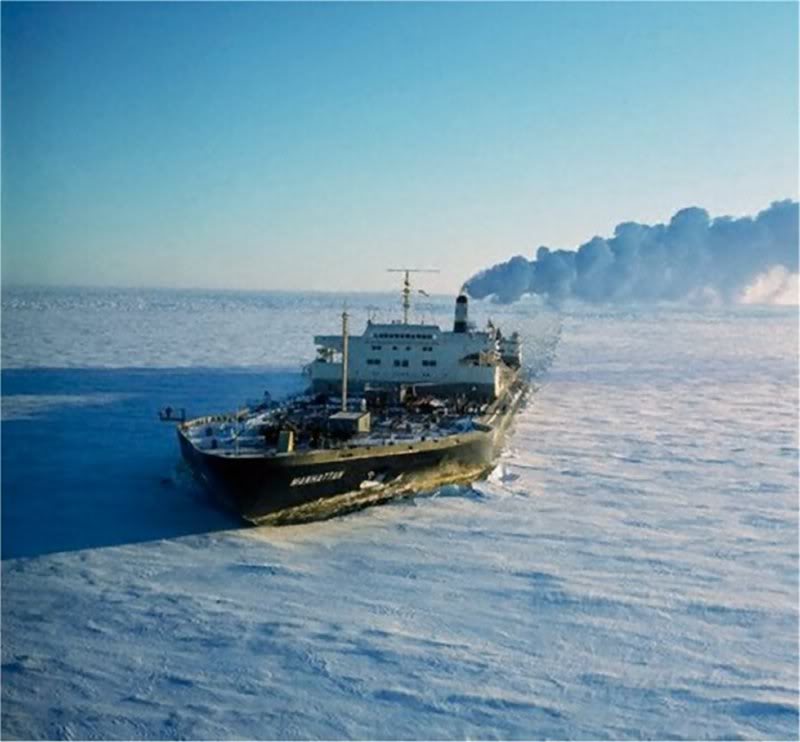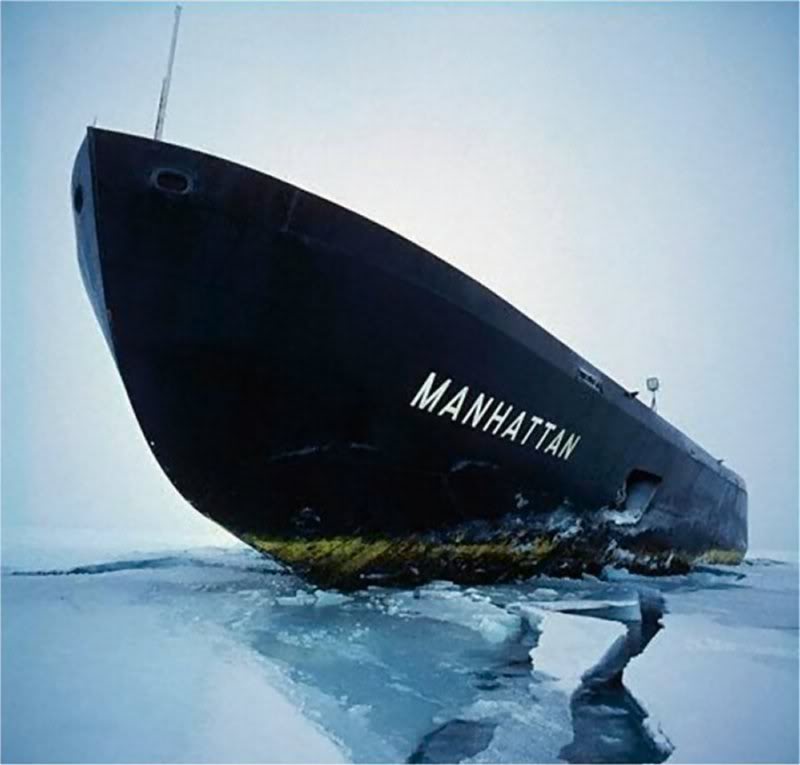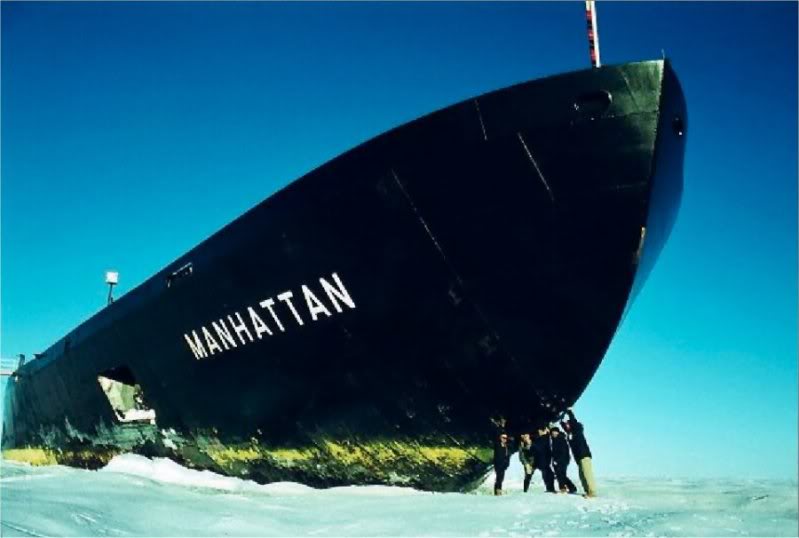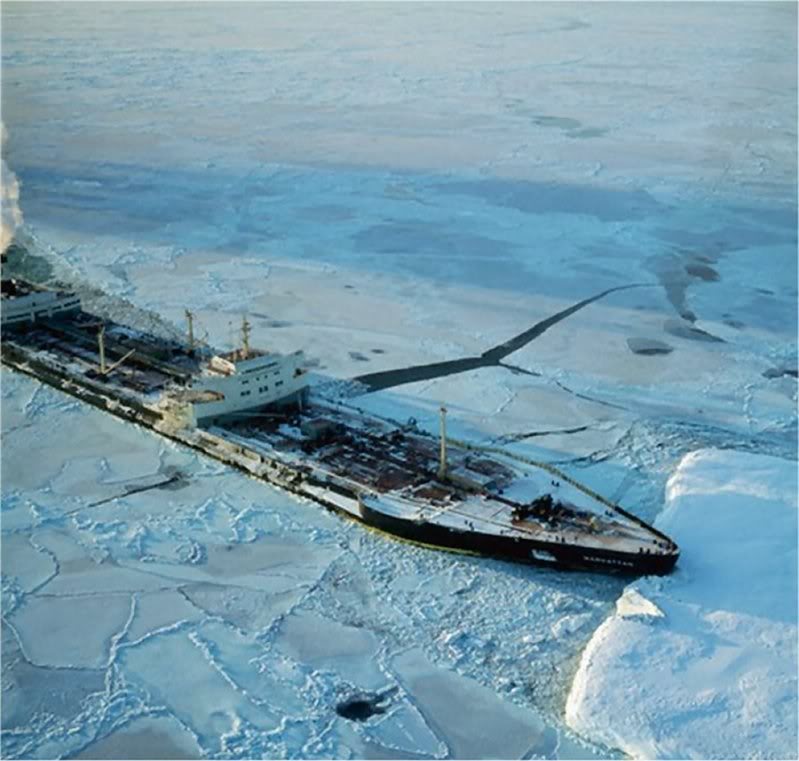Auke Visser's International Esso Tankers site | home
Voyage of Arctic discovery
( From an article in : ) The TANKER Newsletter
TANKERS IN HISTORY
Following conversion to an icebreaker, Manhattan departs for northern waters
Voyage of Arctic discovery
When the 115,000 deadweight ton tanker Manhattan departed Delaware Bay in
August 1969, she was setting out on a voyage of discovery that would test the viability
of modern technology in the most inhospitable of marine environments.
A major oil find at Prudhoe Bay on Alaska's northern coastline in 1968 begged
the question - “What is the optimum route for getting this oil to market - pipeline or
tankers?” As the heavily populated US East Coast loomed as a likely destination,
consideration was given to the use of icebreaking tankers to carry crude oil from
Prudhoe Bay on a 4,400-mile journey through the Northwest Passage to the New
York/Philadelphia area. A little less than half this distance would be through ice cover.
Because there was no previous experience of such voyages and model simulation
would be impossible, it was decided that the only way to test the feasibility of yearround
tanker transportation through the high Arctic at approximately 76° north latitude
would be to conduct a major experiment with a large ship in ice.
Exxon provided the primary financial backing for the project, with BP and Arco,
two of the oil company's North Slope partners, supplying additional funding, and the
Manhattan was taken on charter. At the time, she was the only twin-propeller tanker
of over 100,000 dwt in service and the ship's short cargo tank lengths and Class C
steel deck and upper hull plating were deemed especially suitable for the experiment.
Nevertheless, extensive modification work would be necessary to prepare the vessel
for Arctic service, including strengthening the hull, installing an icebreaker bow and
beefing up the propellers and rudder, as well as their support and protective arrangements.
With Exxon as the project leader and ship operator, Sun Shipbuilding of
Chester, Pennsylvania was chosen to coordinate the work of several US shipyards on
the seven-month conversion, and 10,000 tonnes of steel were ordered to augment the
ship's hull. The hull reinforcement featured the provision of an ice belt in way of the
ship's waterline and a double hull structure to protect the engine, boiler room and
steering gear areas.
When Manhattan departed on her epic voyage, 126 people were onboard, comprising
crew, engineers, scientists, US Congressmen, Canadian Members of Parliament
and media, and her tanks were full of water to simulate a laden voyage. As she
approached the ice fields, the tanker was joined by two icebreakers, one Canadian
and one American. Initially, the ice was new, brackish with salt and weak, but it
wasn't long before hard-set floes of second-year ice, with the salt leached out
and refrozen following the summer melt, was encountered. Manhattan was able to
maintain speed in ice up to 4 feet thick, but ice of uniform thickness on the route
was rare. For the most part the ship had to deal with second-year ice, characterised
by ridges and blocks of ice extending sometimes as much as 50 feet below the
waterline, for which ramming was necessary.
The Manhattan experiment - termed the world's biggest ship model test - cost $54
million to carry out (about $250 million in today's money). A return voyage was
made to further study the ship's capabilities in ice, and the results of both voyages
were utilised in a model basin testing programme that considered the feasibility of
icebreaking tankers of up to 300,000 dwt. The tests showed that such tankers would
require propulsive power four to five times greater than that required for a conventional
tanker. Furthermore, the entire hull structure of such ships would need
to be constructed of low-temperature steels able to withstand the effects of an
Arctic winter without becoming brittle.
“Manhattan's two Arctic voyages were highly successful in providing valuable
data on the performance of large ships in ice and showed that the operation of icebreaking
tankers was a technically and commercially feasible option,” comments
William O (Bill) Gray, Exxon's manager for the Manhattan project and now a
maritime industry consultant.
In October 1970 the oil companies decided that the pipeline alternatives
represented the optimum route for Alaskan North Slope oil and the tanker
studies were suspended, bringing to an end a fascinating experiment in naval
architecture and ship operations. “In view of current discussions on the viability of
the Northern Sea Route in the Russian Arctic to halve the distance between
Europe and Asia, the Manhattan voyages have relevance today,” points out Bill
Gray. “While such a route is not an option for voyages that start and finish in icefree
waters, I believe that under the right circumstances icebreaking tankers could
be competitive for exploiting large oil or gas fields situated in the Arctic polar
region.”
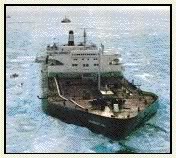
Ice party works alongside the Manhattan.
Manhattan's busy working life
Manhattan was built in the US for the Greek shipowner Niarchos and,
on her delivery in January 1962, she was the largest ship afloat. This distinction
lasted five weeks before the next ship on the world's busy tanker
production line at the time usurped the role.
Sailing with a 45-man crew, Manhattan was employed primarily
carrying gasoline on US domestic routes and in the grain export trades
in the 1960s. Following her Arctic adventure, the ship returned to the grain
trades for several years, before an ironic twist of fate brought her back
to Alaska in 1977. This time it was southern Alaska, however, as she
loaded North Slope oil that had been piped across Alaska to Valdez for
transport to US West Coast refineries.
The tanker's working life drew to premature close in 1987 when a
typhoon drove her aground in the Far East and she was subsequently
scrapped. Manhattan sported her distinctive icebreaker bow until the
very end.
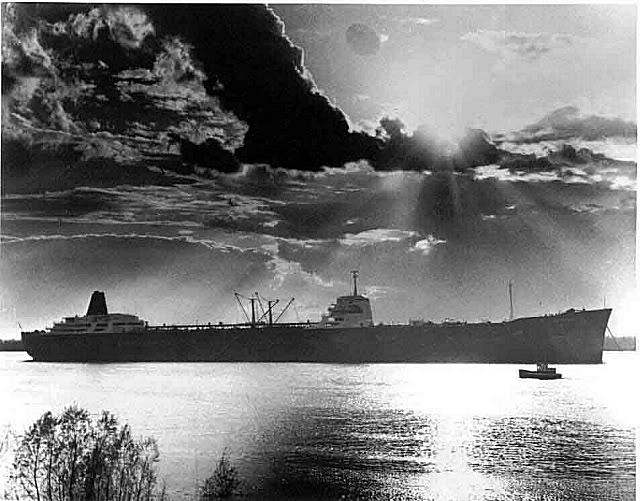
This is a photograph of the American Flag tanker MANHATTAN. Built in 1962, it was, at the time, the biggest ship
under American registry - 105,000 deadweight tons. It would now be dwarfed by many suezmax and vlcc/ulcc tankers.
The MANHATTAN was chartered by a major oil company (ESSO )and extensively modified to be an ice-breaking tanker
for possible use transporting Alaskan North Slope oil through the Northwest Passage. Rather than cutting through the ice, the
MANHATTAN's bow was reinforced so that it could ride up on the ice and break through it with its enormous weight. The
MANHATTAN completed one transit of the Northwest Passage, carrying a single symbolic barrel of North Slope crude.
Subsequently, the Trans Alaska Pipeline was built to Valdez, through which all Alaskan oil moves. The
MANHATTAN was scrapped in 1987.
Manhattan in thick ice.
Manhattan in thick ice.
Manhattan in thick ice.
Manhattan in thick ice.

